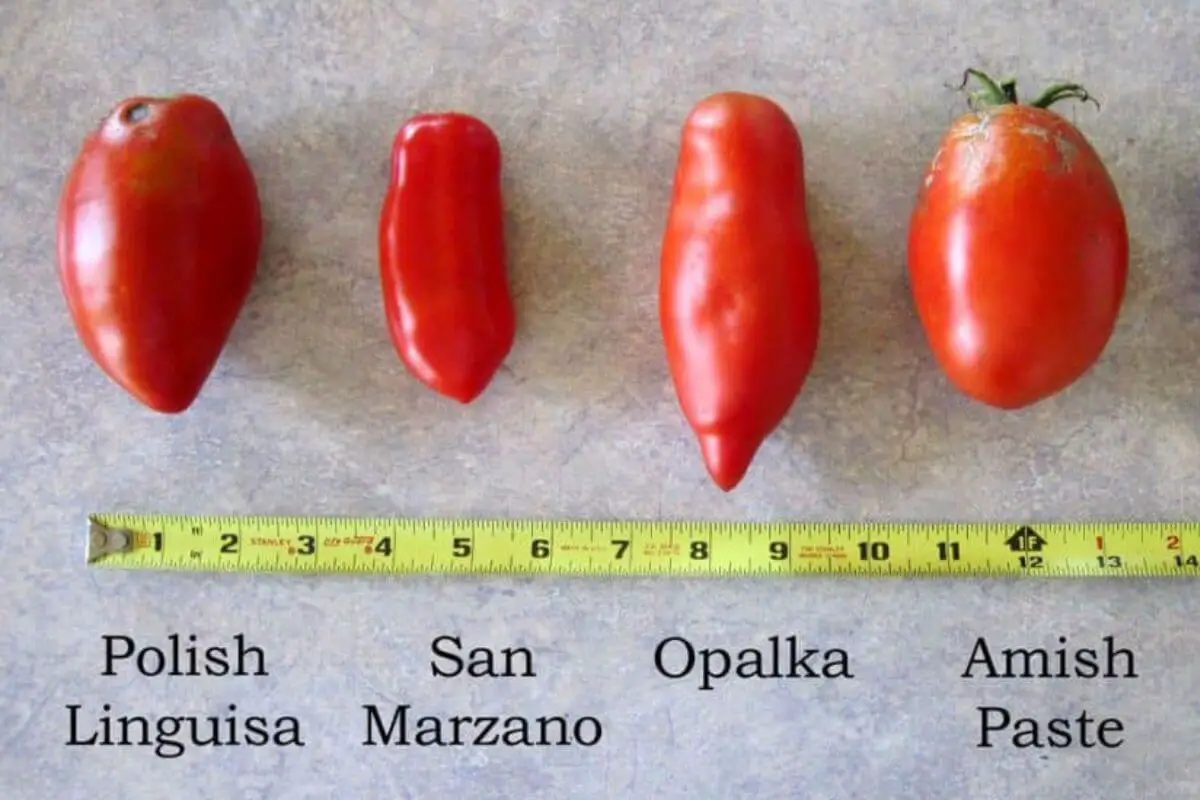Introduction
Tomatoes are a beloved fruit (often mistaken as a vegetable) and are a staple in many culinary creations. When it comes to selecting tomato varieties for your garden or kitchen, Amish Paste and San Marzano are two popular choices. In this article, we will compare Amish Paste Tomato and San Marzano Tomato, delving into their characteristics, flavor profiles, culinary uses, and growing habits to help you decide which tomato variety suits your preferences and needs best.
An Overview of Amish Paste Tomato
1.1 Background and History
The Amish Paste Tomato is a heirloom variety with roots in Amish communities. It is believed to have been passed down through generations, known for its robust flavor and versatility in culinary applications.
1.2 Characteristics of Amish Paste Tomato
Amish Paste Tomato plants are indeterminate, meaning they continue to produce fruit throughout the growing season until the first frost. The plants are vigorous and can reach a considerable height, requiring sturdy support. The tomatoes are meaty with fewer seeds, making them ideal for sauces and canning.
1.3 Flavor Profile of Amish Paste Tomato
Amish Paste Tomatoes boast a rich and sweet flavor with a good balance of acidity. The flesh is dense and has a smooth texture, making it a preferred choice for cooking down into sauces, pastes, and soups.
Exploring San Marzano Tomato
2.1 Background and Origin
San Marzano Tomato is a classic Italian heirloom variety cherished for its culinary excellence. It originated in the town of San Marzano sul Sarno in Italy’s Campania region.
2.2 Characteristics of San Marzano Tomato
San Marzano Tomato plants are indeterminate, similar to Amish Paste, and continue to produce fruit throughout the growing season. The tomatoes are elongated and cylindrical, known for their distinctive shape. They are generally smaller than Amish Paste tomatoes.
2.3 Flavor Profile of San Marzano Tomato
San Marzano Tomatoes are famous for their sweet and rich flavor with low acidity. The flesh is thick and has fewer seeds, making them prized for creating sauces, especially the traditional Italian tomato sauce.
Comparing Amish Paste and San Marzano
3.1 Fruit Size and Shape
Amish Paste tomatoes are larger and more rounded, while San Marzano tomatoes are smaller and elongated. The shape of the tomatoes influences their suitability for different culinary uses.
3.2 Culinary Uses and Suitability
Both Amish Paste and San Marzano tomatoes are highly regarded for their culinary uses, particularly in sauce-making and canning. Amish Paste tomatoes’ larger size makes them suitable for slicing and fresh eating as well.
3.3 Growing and Care Requirements
Both tomato varieties require similar growing conditions, including full sun, well-draining soil, and regular watering. They can be grown in gardens or containers with proper support for the indeterminate plants.

3.4 Overall Versatility and Performance
Amish Paste tomatoes are known for their versatility, excelling in a wide range of dishes from salads to soups. San Marzano tomatoes are celebrated for their exceptional performance in pasta sauces, where their dense flesh and sweet flavor shine.
Choosing the Right Tomato for You
4.1 Home Gardening Considerations
Consider the available space and support structures in your garden when choosing between the two tomato varieties. If you have ample space and prefer larger tomatoes for a variety of uses, Amish Paste may be a good fit. If you are limited on space and desire smaller tomatoes specifically for sauce-making, San Marzano is an excellent choice.
4.2 Culinary Applications
Think about the specific culinary applications you have in mind for the tomatoes. If you plan to make various dishes like salads, soups, and sauces, Amish Paste’s versatility may be preferable. If your primary focus is on creating authentic Italian pasta sauces, San Marzano’s distinct flavor and shape make it a top contender.
4.3 Taste and Flavor Preferences
Taste and flavor preferences play a significant role in tomato selection. If you prefer a sweeter and less acidic tomato, both Amish Paste and San Marzano will satisfy your palate. Personal taste preferences should guide your final decision.
Conclusion
In conclusion, both Amish Paste Tomato and San Marzano Tomato are outstanding choices for home gardeners and culinary enthusiasts. Their rich flavors, meaty texture, and culinary versatility make them valuable additions to any garden and kitchen. When deciding between the two, consider your garden space, culinary aspirations, and flavor preferences to select the perfect tomato variety for your needs.
With either Amish Paste or San Marzano, you can delight in the rich flavors of homegrown tomatoes and elevate your culinary creations to new heights.
FAQs
Which tomato variety is better for making sauces?
Both Amish Paste Tomato and San Marzano Tomato are excellent choices for making sauces due to their meaty texture and rich flavor. However, San Marzano tomatoes are particularly renowned for their exceptional performance in traditional Italian pasta sauces.
Can I grow Amish Paste and San Marzano tomatoes in containers?
Yes, both Amish Paste and San Marzano tomatoes can be grown in containers, provided they have enough space and support for their indeterminate growth. Using large containers with sturdy stakes or cages will help these tomato plants thrive on patios or balconies.
Are Amish Paste tomatoes good for fresh eating?
Yes, Amish Paste tomatoes can be enjoyed fresh in salads or sandwiches, thanks to their delicious sweet and tangy flavor. Their larger size and meaty texture make them suitable for slicing and eating fresh.
Which tomato variety has fewer seeds?
Both Amish Paste and San Marzano tomatoes have fewer seeds compared to many other tomato varieties. Their thick flesh contributes to a reduced seed content, making them ideal for sauces and paste-making.
Can I use Amish Paste and San Marzano tomatoes interchangeably in recipes?
While both tomatoes are versatile and can be used in various recipes, their size and shape may affect their suitability for specific culinary applications. For pasta sauces, San Marzano tomatoes are the traditional choice due to their elongated shape and rich flavor.
Do Amish Paste and San Marzano tomatoes require staking or support?
Yes, both tomato varieties are indeterminate and will continue to grow and produce fruit throughout the growing season. Providing adequate support, such as stakes or cages, is essential to keep the plants upright and prevent sprawling.
Which tomato variety is more resistant to diseases and pests?
Both Amish Paste and San Marzano tomatoes can be susceptible to common tomato diseases and pests. Proper gardening practices, such as crop rotation, good hygiene, and using disease-resistant varieties, can help minimize potential issues.
Can I save seeds from Amish Paste and San Marzano tomatoes for next year’s planting?
Yes, you can save seeds from both Amish Paste and San Marzano tomatoes for next year’s planting. However, it is essential to ensure that the tomatoes are fully ripe before collecting seeds and to properly dry and store them in a cool, dry place.
Do these tomato varieties have distinct growing requirements?
Amish Paste and San Marzano tomatoes have similar growing requirements. They thrive in full sun, well-draining soil, and regular watering. Ensuring proper support for the indeterminate plants is vital for a successful harvest.
Where can I purchase seeds or seedlings of Amish Paste and San Marzano tomatoes?
Seeds or seedlings of both Amish Paste and San Marzano tomatoes are available at garden centers, nurseries, and online seed retailers. Choose reputable sources to ensure the quality and authenticity of the tomato varieties.
Whether you’re a seasoned gardener or a tomato enthusiast looking to elevate your culinary creations, both Amish Paste and San Marzano tomatoes offer exceptional flavors and versatility to enhance your gardening and cooking experience.



